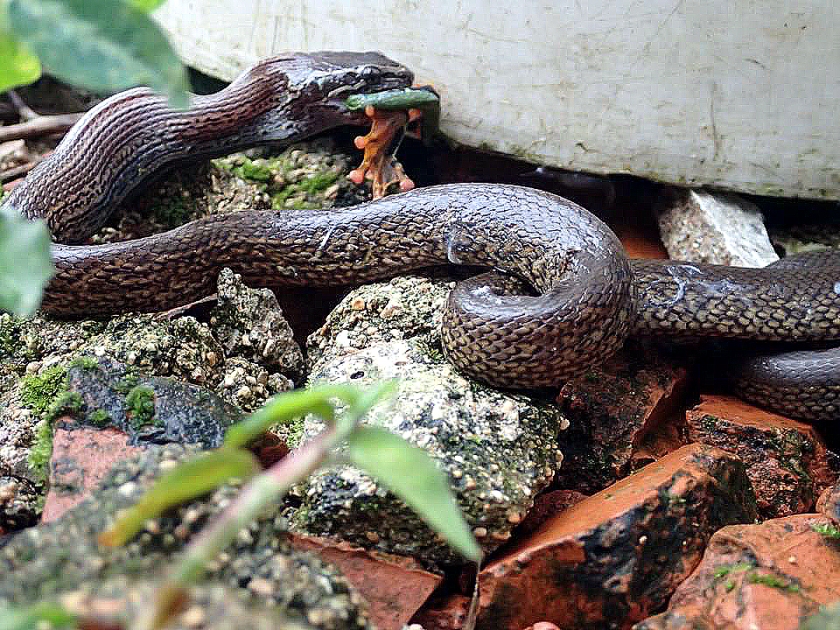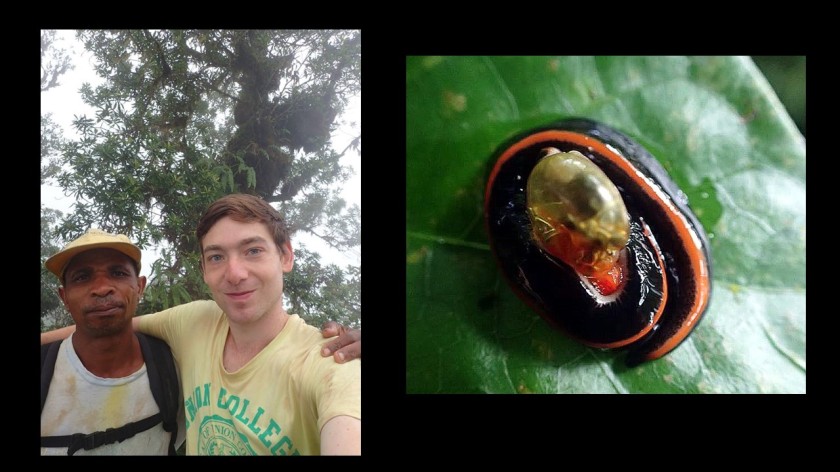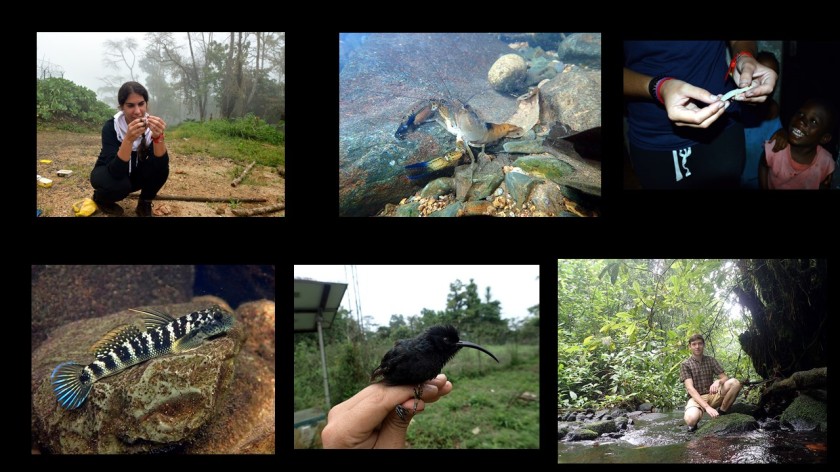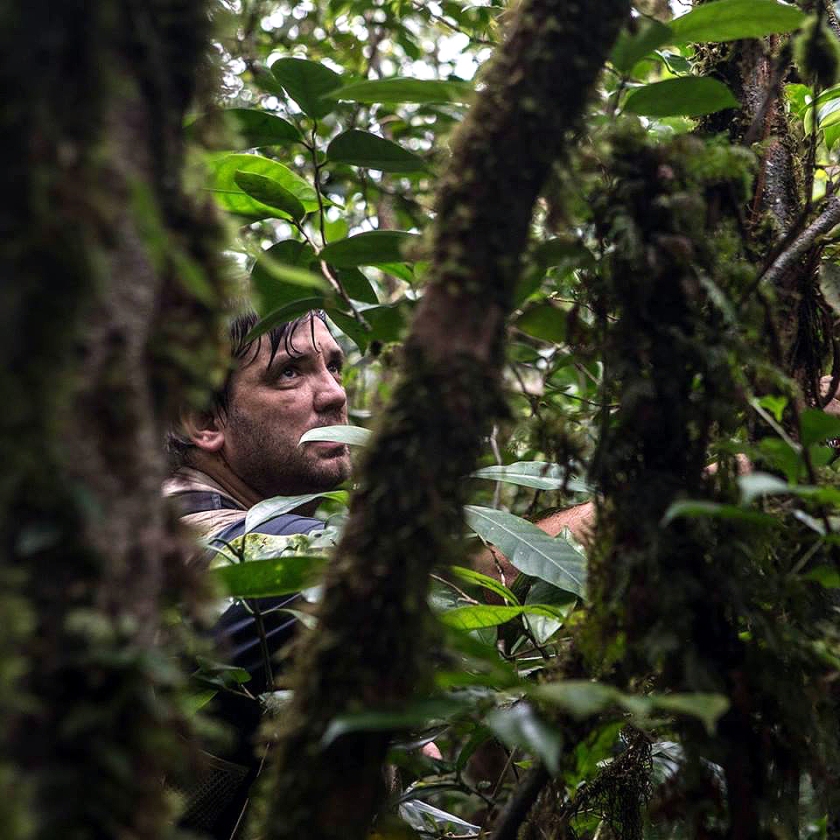Note: This blog and the preceding one are dedicated to the memory of our friend Bill Bowes, of the William K. Bowes Jr. Foundation, who graciously lent his personal encouragement to and support for the GG IX, X and XI expeditions. We of the Gulf of Guinea team and the California Academy of Sciences will miss him very, very much.

The São Tomé weaver (Ploceus sanctithomae] is a forest species known only from the big island. Phot. P. Loureiro.
During Gulf of Guinea IX, two years ago, our education effort was focused on the endemic bird species of both islands; as mentioned before, the bird fauna is hugely important; the two islands have perhaps the highest number of unique bird species by area in the world, 28 endemics/1000km ².

The São Tomé Prinia. (Prinia molleri). The “Truqui” is found only on the big island and is probably the most common endemic species there (top photo. P. Loureiro.) As we visited the classrooms, each student got a pair of plastic binoculars (they work!), and our booklet that highlights some of the most beautiful species on both islands and their natural history (above, left and right. phots by A. Stanbridge).

And, expedition patches are given by the teachers to 10 students who do the best work each year. (photo by A. Stanbridge, above)
Our intent is always to instill in the kids a sense of ownership for these species for their uniqueness and beauty: “No one else has these, even on the other island!” The image below was taken by our senior educator, Roberta Ayres, but it might have been made anywhere little kids play. Regardless, we never preach in our classroom presentations; we present the species of the flora and fauna as rare and beautiful.

Our Gulf of Guinea Islands project is indeed multiplex, and some of the most interesting scientific discoveries in past years have been made by graduate students in pursuit of higher degrees.

Recently, Ana P. Coelho (above middle), received her MSc degree in conservation biology from the University of Lisbon; her thesis advisor was our long-time colleague, Dr. Ricardo Lima (left), whose earlier PhD thesis was also based on the island ecology.

Field assistant Octavio, mist-nettng (A. Coelho phot.)
Ana studied the roles of birds in dispersing seeds on São Tomé. Some 18 species of birds, all endemic, were systematically mist-netted (above), and ring-banded (below). Their droppings were studied over time to determine what seeds the fruit-eating (frugivorous) species were eating. The field/data collection part of the study was several months in duration.

Ana banding an endemic São Tomé scops owl , Otus hartlaubi. (A. Carvalho phot)
Of the 18 species captured and released, nine were frugivorous, and Ana showed that the great majority of seeds they ate were in the fruit of endemic or native plant species. Some species of non-native plants were ingested and dispersed as well.

Birds of larger size (and thus larger beak gape) eat larger fruit (above).
This relationship among endemics makes evolutionary sense. We know that the accumulation of genetic (and morphological) change leading to the evolution of new species takes isolation and time. This is as true for the consumer (the birds) as it is for the energy source (the fruit of the plants). So one can suggest that the birds and the seed plants upon which they feed co-evolved over thousands of years. The birds benefit from the fruits of the plants and in turn, the plants’ seeds are carried to distant environments (along with fertilizer) in the bird droppings.

The São Tomé speirops (above) is by far the most frequent seed disperser; Ana found this endemic produced 84% of all droppings containing seeds. .
However, it should be noted that in this case, the birds are also responsible for a rather difficult conservation issue. Through seed dispersal of endemic plants, they are contributing to native forest regeneration, but because they also disperse a number of non-native plant species, the birds are also involved in biological invasion – the spread of alien species..

Above is an additional endemic predator/prey relationship: a São Tomé house snake ingesting a São Tomé giant tree frog; both species are endemic to the big island. (Matthias Neumann phot. )
Another recent graduate student contributor to our scientific knowledge of Gulf of Guinea biology is Matthias Neumann (below), who recently completed his MSc in biology at the University of Kassel in Germany.

(M. Neumann phot)
Matthias spent a couple of months in the islands last year collecting and studying geoclads (flatworms), many species of which are known to be predatory on snails.
We have made the point in earlier blogs that these flatworms are potentially very important because the land snail fauna of both islands is over 70% unique, and if these flatworms are recent arrivals, they may pose a real danger to the existence of the endemic snails. Prior to Matthias’ field investigations almost nothing was known about the island flatworm fauna except for some random observations by some of us working in the forests (see earlier blogs).

Mathias (left) with field assistant, Lionel; a geoclad feeding on a terrestrial snail (right). M. Neumann phots.
Matthias was successful in completing his degree, and his work has recently been published: Sluys R., M. Neumann, R.F. de Lima, & R, C. Drewes. 2017. Land flatworms (Platyhelminthes, Geoplanidae) of São Tomé: a first account on their diversity, with the description of five new species. Zootaxa 4221 (3): 291–322.
Matthias estimates that there at least as many additional undescribed flatworm species on the islands awaiting identification and study. Two of the species he has discovered so far are definitely snail predators. If these two species are long-time inhabitants of the islands, it is likely they have co-evolved with their snail prey, a situation probably not unlike the endemic bird/endemic plant relationship studied by Ana Coelho. There is so much more to be learned in these islands.

As Ana’s and Matthias’s photos above suggest, both of these young scholars are born naturalists, interested in a wide range of living species. The images include a freshwater blenny, a freshwater shrimp, a São Tomé house snake and a giant sunbird, all endemic or native to the islands.
The Parting Shot:

Dr. Cesar Garcia, of Lisbon, working on Principe. Fieldwork is always exhausting, occasionally painful but forever a joy!
PARTNERS
Our research and educational expeditions are supported by tax-deductable donations to the “California Academy of Sciences Gulf of Guinea Fund*.” We are grateful for ongoing governmental support from the Republic of São Tomé and Príncipe, and especially to Arlindo de Ceita Carvalho, Director General, Victor Bonfim, and Salvador Sousa Pontes of the Ministry of Environment and to Faustino de Oliviera of the Department of Forestry for their continuing authorization to collect and export specimens for study, and to Ned Seligman, Roberta dos Santos and Quintino Quade of STePUP of Sao Tome, our “home away from home”. GG IX, X and XI have been funded in part by a generous grant from The William K. Bowes Jr. Foundation, and substantial donations from Rod C. M. Hall, Mr. and Mrs. Henri Lese, Mr. and Mrs. John L. Sullivan Jr., Mr. and Mrs. John Sears, in memory of Paul Davies Jr. and a heartening number of Bohemian friends. We are grateful for the support of the Omali Lodge (HBD-São Tomé) and Roça Belo Monte (Africa’s Eden-Príncipe) for both logistics and lodging.
*California Academy of Sciences
55 Music Concourse Dr.
San Francisco, CA 94118
